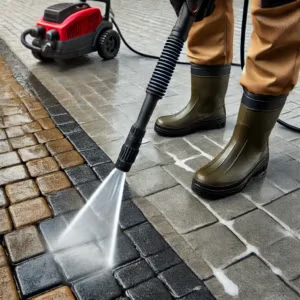Paver Cleaning and Sealing: Tips for Long-Lasting Patio Pavers
Patio pavers are a beautiful and functional addition to any outdoor space, but without proper care, they can become worn and dirty. Regular cleaning and sealing are crucial to maintaining their appearance and longevity. In this blog, we’ll discuss the best practices for paver cleaning and sealing to ensure they remain in excellent condition for years to come.
For expert tips on paver cleaning and sealing, read this blog.
Why Paver Cleaning and Sealing is Important
Pavers are constantly exposed to the elements, foot traffic, and sometimes even vehicle traffic. This can lead to dirt buildup, stains, and weed growth between the joints. Sealing your pavers adds a protective layer that not only enhances their color and texture but also protects them from stains, UV rays, and erosion. Paver cleaning and sealing will extend the lifespan of your patio and make it easier to clean in the future.
To keep your sidewalk and patio spotless, read this blog.
Steps for Proper Paver Cleaning
1. Remove Debris
Before cleaning your pavers, remove any loose debris such as leaves, dirt, and rocks. Use a broom or a leaf blower to clear the area. Removing debris will make the cleaning process more efficient and prevent scratches during washing.
2. Pre-Treat Stains
For stubborn stains like grease or oil, apply a pre-treatment solution to the affected areas and let it sit for about 10-15 minutes. This will help loosen the stains, making them easier to remove during pressure washing.
3. Pressure Wash the Pavers
Use a pressure washer with a wide nozzle to clean the pavers. Make sure to use a moderate pressure setting to avoid damaging the surface. Pressure washing removes dirt, algae, and grime from the surface of the pavers, restoring their original color and beauty.
For a complete guide on how to power wash driveways and concrete, read this blog.
4. Let the Pavers Dry Completely
Once you’ve finished pressure washing, allow the pavers to dry completely before moving on to the sealing process. Depending on the weather, this may take 24-48 hours. Sealing the pavers while they’re still wet can trap moisture, leading to discoloration or mold growth.
Sealing Your Patio Pavers
Sealing your pavers is a crucial step in ensuring their long-term durability. Here’s how to do it right:
1. Choose the Right Sealer
There are different types of sealers available, including:
✔ Penetrating sealers – for deep protection without altering the appearance
✔ Film-forming sealers – for added shine and color enhancement
✔ Wet-look sealers – for a glossy finish and enhanced color
Sealing provides a barrier that prevents water, dirt, and stains from penetrating the surface.
2. Apply the Sealer Evenly
Using a roller or sprayer, apply the sealer evenly across the paver surface. Be sure to cover all joints and edges for maximum protection. Applying the sealer too thickly can result in an uneven finish, so use multiple thin layers if needed. Even application ensures long-lasting results.
3. Allow Time to Dry
Let the sealer dry for at least 24-48 hours before allowing foot or vehicle traffic on the pavers. This gives the sealer enough time to bond with the surface and provide full protection.
4. Maintain Your Sealed Pavers
✔ Sweep away debris regularly
✔ Hose down the surface to remove dirt and dust
✔ Reapply sealer every 2-3 years to keep your pavers looking like new
For expert solutions on concrete coating and floor transformation, read this blog.
Other Outdoor Surfaces That Benefit from Cleaning and Sealing
-
Decks & Fences: Regular deck and fence cleaning restores their beauty and prevents wood rot.
Learn more about deck and fence cleaning in this blog. -
Sidewalks & Patios: Pressure washing removes dirt, grime, and mildew buildup from your outdoor spaces.
For a complete sidewalk and patio cleaning guide, read this blog. -
Driveways & Concrete Surfaces: Cleaning your driveway and concrete helps maintain their durability and appearance.
For more details on keeping your concrete spotless, read this blog.
How Around The Bend Pressure Washing Can Help
At Around The Bend Pressure Washing, we offer expert paver cleaning and sealing services in Tallahassee and surrounding areas. Our team uses top-quality products and techniques to ensure your pavers are clean, sealed, and protected for years to come.
For a complete residential pressure washing guide, read this blog.

